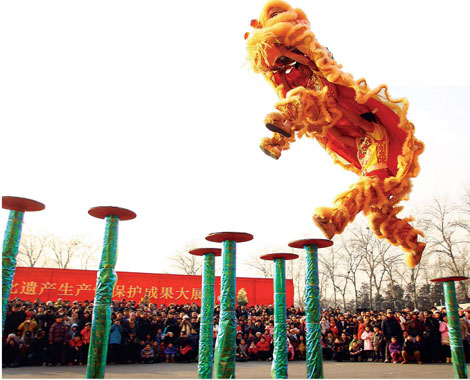
Two lion dancers from the Huang Feihong Lion Dance Troupe perform at Exhibition of Achievements on the Productive Protection of China's Intangible Cultural Heritage. Photos by Zou Hong / China Daily
A massive exhibition with performances in Beijing examines intangible heritage protection through profit generation. Mu Qian reports.
Beijing returned to normal after the Lantern Festival, but the festive atmosphere lingered at the National Agriculture Exhibition Center, where folk dancers staged nightly shows. But they didn't simply present traditional dances.
They also demonstrated the modern trend of "productive protection", in which intangible cultural heritage is sustained by free market commercialization. A group of lion dancers from Nanhai, Guangdong province, performed twice a day in the venue's courtyard between Feb 5 and 15.
They participated in the Exhibition of Achievements on the Productive Protection of China's Intangible Cultural Heritage, which ended on Feb 15.
Performer He Cantian says: "I'm happy to present this tradition from South China's Guangdong province to North China's audiences in Beijing. It's not just a local tradition but also a form of national intangible cultural heritage."
As drums and gongs clashed, the lion leaped onto and balanced on two poles - no easy task for He and his partner.
Guangdong's lion dance is based on its local kungfu style. He's Huang Feihong Lion Dance Troupe takes its namesake from the martial arts school's master. He's teacher studied under Huang's descendent.
"My teacher always says every generation of lion dancers should do what they can to pass down the tradition," He says.
The 27-year-old and his fellow lion dancers are doing so by making it their profession, he says. He studied the folk performance art as a child and went pro in 2006. Their team regularly stages shows at the Huang Feihong Guild Hall in Guangdong's Nanhai. They also perform at such occasions as weddings, birthday parties and company events.
"Since lion dancing is how we earn our living, we must do it really well," He says.
He's dance troupe is one of four performing at the Beijing event.
Others presented the dragon dance of Chongqing, yangge of Shandong province, "nine lions" dances from Zhejiang, and the Taiping drum dance from Beijing. All are professional or semiprofessional.
Besides the dances, the exhibition brought about 170 folk artists to the venue to demonstrate their skills in creating pottery, embroideries, wood sculptures, weavings, paper-cuts and traditional Chinese medicine.

Copyright ©1999-2011 Chinanews.com. All rights reserved.
Reproduction in whole or in part without permission is prohibited.